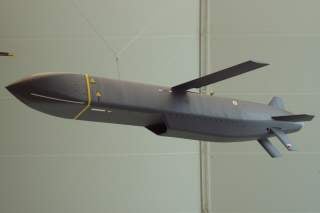France's Tried to Make Its Own 'Tomahawk' Missile (But It Isn't Going Well)
Lots of problems.
Key point: France's MdCN and SCALP missiles have performed poorly in Syria.
The jury is still out on how effective Russian and Syrian air defenses were in the April 18, 2018, missile strikes against Syria. While the United States claims that all missiles hit the targets and the Russian MoD claims that over 65 percent of the missiles were intercepted, the truth may not be known for some time.
What is known is that some missiles suffered considerable technical difficulties during the strike. The French MdCN and SCALP cruise missiles had the worst performance, misfiring or not even firing at all in some cases. What are some reasons for this happening? Is it the relative immaturity of these weapons and their integration on the launching platforms? Could this potentially hurt sales of the MdCN?
The MdCN and SCALP missiles are closely related. The MdCN is the naval vertical launched cruise missile version of the SCALP, which was an evolution of an earlier runway-busting missile. Both the MdCN and SCALP have similar characteristics: weights slightly shy of half a metric ton and a length of around half a meter.
The primary difference is that the MdCN uses a booster during its launch phase to break out of the ship and gain some initial velocity, whereas the SCALP inherits that when it is launched from a plane. This booster gives the MdCN significantly increased range. One source cites one thousand kilometers for the MdCN versus four hundred kilometers for the SCALP.
The MdCN is also more recent; it was first procured in 2014 as opposed to the SCALP which was operational by the early 2000s. Part of the reason for the MdCN’s later development is it was developed to be deployed from a new series of French ships: the FREMM multi-role frigate that began to enter service in 2012.
The new nature of the ships and MdCN’s integration into them probably caused one of the largest issues during Operation Hamilton (France’s portion of the April missile strikes). Two frigates suffered computer issues and were unable to launch MdCNs at all, only the third frigate was able to launch. This resulted in far fewer MdCNs being launched than the original strike plan called for.
SCALP also suffered issues. Five Rafale fighters took off with ten SCALPs in total under their wings. Nine were fired successfully, but the last failed an internal self-check and refused to launch off the rail, and was thus ditched into the sea. Here the cause is clear, the missile itself malfunctioned.
However, the problems with the frigates suggest that the MdCN is having significant integration issues with the host platform, as opposed to with the missile itself. A French MP has revealed some portions of the after-action reports (RETEX) concerning those strikes. It suggests that some FREMMs deployed during the operation were not fully operationally ready, only having been pulled off exercises a few days before. It also suggests that the French Navy needs to conduct more exercises where they actually shoot complex ammunition, instead of just simulating it.
While these same reports suggest that the problems with MdCN have already been fixed or are being fixed at the present, one can’t help but think how these incidents are harming potential export prospects for the MdCN. One big customer was Poland, who was looking for new submarines for their navy. France offered a package that included subs and MdCNs that could be launched from them, giving the subs substantially increased strike capability (similar to earlier sub-launched tomahawks).
It’s unsure whether Polish buyers have been reassured by French promises. However one must remember that during the Tomahawk’s first operational uses in Operation Desert Storm, it encountered similar issues with missiles not leaving the tube or going wild after launch. Russian Kalibrs have also supposedly gone wild in flight.
Developing naval cruise missiles is hard, and while France is having difficulty now, it is one of the only European nations that has the capability to develop such a missile. If Europe wants to remain relatively independent in their defense procurement, then MdCN may have to be a key part of that policy, at least for strategic strike.
Charlie Gao studied political and computer science at Grinnell College and is a frequent commentator on defense and national-security issues. This first appeared in November 2018.
Image: Wikimedia Commons.

